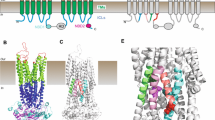Abstract.
The cystic fibrosis transmembrane conductance regulator (CFTR) is a member of the superfamily of ATP-binding cassette (ABC) transporters, also known as traffic ATPases. Recent studies from our laboratory determined that various members of the ABC family of transport proteins mediate the electrodiffusional movement of the nucleotide ATP. In this report, evidence for the movement of cellular nucleotides by the ABC transporter CFTR and related molecules, including P-glycoproteins (Pgp), is reviewed. The wild-type mdr1 gene product, Pgp, enables the spontaneous release of cellular ATP. However, single amino acid substitutions in both nucleotide-binding sites render a dysfunctional Pgp, whose function can only be reversed by voltage activation. This report includes data indicating that reconstitution of highly purified CFTR from human epithelial origin enables the permeation of both Cl and ATP. The relevance of the ABC domains in ATP transport is also explored, and the hypothesis is forwarded that improper ATP transport by a dysfunctional CFTR is a relevant factor in cystic fibrosis.
Similar content being viewed by others
Author information
Authors and Affiliations
Additional information
Electronic Publication
Rights and permissions
About this article
Cite this article
Cantiello, .H. Electrodiffusional ATP movement through CFTR and other ABC transporters. Pflügers Arch - Eur J Physiol 443 (Suppl 1), S22–S27 (2001). https://doi.org/10.1007/s004240100639
Issue Date:
DOI: https://doi.org/10.1007/s004240100639




